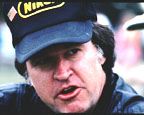 Grassroots
Grassroots 
On Being Invisible
“Sometimes we’re all alone in a crowd"
Officially Oshkosh was over. Only a few hours earlier, a voice had boomed over the PA system saying thanks and come again next year. That was the signal that it was time to return to the real world and normalcy. However, those of us milling around the boarding lounge at Appleton Airport waiting for our commuter flight were mentally and emotionally still walking the grounds at Oshkosh. We weren’t ready for normalcy yet.
As we waited, the unspoken bond born of the sure knowledge that each of us was there for the same reason was unbroken. Our very presence at Oshkosh had established at least one fact: we were all aviators and that made us willing to reach out and talk to the next person. We were a community.
As we sat in the departure lounge waiting to re-enter a world that could only be described as “Not Oshkosh,” the baseball caps and T-shirts said that 100% of the passengers were fly-in refugees flooding out on their way to somewhere. I talked to a young man who wanted to build a Bearhawk. Another gentleman was on this third Pitts. Another on his fourth Cub. Then, we lined up at the gate and began our cattle car rush to Chicago and points unknown.
During the short flight south, there was little talking. This I thought was odd until I noticed I wasn’t talking either. We were each savoring our own thoughts as if preparing for what we knew was to come next. And when it happened, it rolled over us with the suddenness of a flash flood.
The instant we stepped out of the boarding bridge at ORD, we were swept away in the harried flow of people that typifies major airports everywhere. For the first 50 yards or so, you’d see a familiar baseball cap bobbing along in the crowd or catch a fleeting glimpse of the ever-present EAA logo. Then it was all gone. Dilution was complete. Oshkosh was over. The community was scattered and you stopped looking at faces thinking you might know them. People became nothing more than two-legged projectiles to be avoided in your headlong rush to stand in the next line.
We had a two-hour lay over at O’Hare and I was sitting there, my legs dovetailed with those in the facing seats, when I saw her. I was half-asleep and looking at the floor when I saw the flash of a hand-push vacuum between feet under the seats in front of me.
I glanced up and traced the handle to a woman. Maybe thirty-five. Maybe fifty-five. It was hard to tell. She was floating along, deftly dancing through the crowd, her sweeper flicking out like a frog’s tongue as it captured crumbs and bits of trash.
I began watching her eyes and then studied the eyes of others in the crowd. She didn’t even see us. We were just so much noisy furniture she had to sweep around. To the crowd, she was just an extension of the sweeper: a noiseless entity that fluttered around their feet that somehow managed to avoid getting under foot. She was very good at what she did. And she did it with total invisibility. She didn’t see us. We didn’t see her.
Somewhere in the massive crowd there were a bunch of pilots who only a few hours earlier had been part of a community but were now invisible bits of flotsam with no identity. We were between worlds. Oshkosh was left behind and we were migrating back to the worlds we call home. In so doing we crossed paths with the sweeper lady, but virtually none of us did so much as meet her eyes.
At the time, I thought that was sad. I saw her as being alone in a crowd. Then I realized I had it backward—I was the one who was alone in a crowd. We were all alone in a crowd. To her, however, there was no crowd. We were just stuff on her floor and this was her world. She wasn’t alone. She was home.
Without knowing it, I had seen this woman before. Back at Oshkosh, she had been the waitress at the restaurant, the desk clerk at the motel, the dozens, maybe hundreds, of people who call Oshkosh home whom I had interfaced with in the course of the week. To them, I was just a face in the crowd that always showed up for the Fly-in. To us, they were the people who were always there running the support systems around the big event.
At the exact moment that I was watching the sweeper lady, back in Oshkosh the Town, “Welcome EAA” signs were coming down, the “Vacancy” neon at hotels was again glowing and that part of Wisconsin was beginning to breathe easy. It was returning to normal.
When each of us step off the next airplane at home, Oshkosh will have been left far behind and we will also have returned to normal. We’ll all have a short period of re-adjustment, but as work and family regain their rightful positions in our lives, we’ll get over the re-entry blues quickly. Then, without even realizing it, we’ll start counting down the days before we again make our emotionally-necessary pilgrimage back to av-land. It’s a predictable cycle. Swallows have Capistrano. We have Oshkosh.